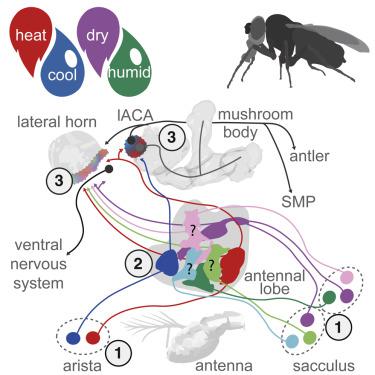Current Biology ( IF 8.1 ) Pub Date : 2020-07-02 , DOI: 10.1016/j.cub.2020.06.028 Elizabeth C Marin 1 , Laurin Büld 1 , Maria Theiss 1 , Tatevik Sarkissian 2 , Ruairí J V Roberts 1 , Robert Turnbull 1 , Imaan F M Tamimi 1 , Markus W Pleijzier 3 , Willem J Laursen 2 , Nik Drummond 1 , Philipp Schlegel 4 , Alexander S Bates 3 , Feng Li 5 , Matthias Landgraf 1 , Marta Costa 1 , Davi D Bock 6 , Paul A Garrity 2 , Gregory S X E Jefferis 4

|
Animals exhibit innate and learned preferences for temperature and humidity—conditions critical for their survival and reproduction. Leveraging a whole-brain electron microscopy volume, we studied the adult Drosophila melanogaster circuitry associated with antennal thermo- and hygrosensory neurons. We have identified two new target glomeruli in the antennal lobe, in addition to the five known ones, and the ventroposterior projection neurons (VP PNs) that relay thermo- and hygrosensory information to higher brain centers, including the mushroom body and lateral horn, seats of learned and innate behavior. We present the first connectome of a thermo- and hygrosensory neuropil, the lateral accessory calyx (lACA), by reconstructing neurons downstream of heating- and cooling-responsive VP PNs. A few mushroom body-intrinsic neurons solely receive thermosensory input from the lACA, while most receive additional olfactory and thermo- and/or hygrosensory PN inputs. Furthermore, several classes of lACA-associated neurons form a local network with outputs to other brain neuropils, suggesting that the lACA serves as a hub for thermo- and hygrosensory circuitry. For example, DN1a neurons link thermosensory PNs in the lACA to the circadian clock via the accessory medulla. Finally, we survey strongly connected downstream partners of VP PNs across the protocerebrum; these include a descending neuron targeted by dry-responsive VP PNs, meaning that just two synapses might separate hygrosensory inputs from motor circuits. These data provide a comprehensive first- and second-order layer analysis of Drosophila thermo- and hygrosensory systems and an initial survey of third-order neurons that could directly modulate behavior.
中文翻译:

连接组学分析揭示了成年果蝇大脑中的一阶、二阶和三阶热感觉和湿度感觉神经元。
动物对温度和湿度表现出先天和后天的偏好,这些条件对其生存和繁殖至关重要。利用全脑电子显微镜体积,我们研究了与触角温度和湿度感觉神经元相关的成年果蝇电路。除了五个已知的目标肾小球外,我们还确定了触角叶中的两个新的目标肾小球,以及将热和湿度信息传递到高级大脑中心的腹后投射神经元(VP PN),包括蘑菇体和侧角、座位后天习得的和先天的行为。我们通过重建加热和冷却响应 VP PN 下游的神经元,提出了热感和湿感神经元的第一个连接组,即侧副花萼 (lACA)。一些蘑菇体固有神经元仅接收来自 lACA 的热感觉输入,而大多数神经元接收额外的嗅觉和热和/或湿度感觉 PN 输入。此外,几类与 lACA 相关的神经元形成了一个局部网络,输出到其他大脑神经元,这表明 lACA 是温度和湿度感觉电路的枢纽。例如,DN1a 神经元通过附属髓质将 lACA 中的热感 PN 与生物钟联系起来。最后,我们调查了整个原大脑中与 VP PN 紧密相连的下游伙伴;其中包括干反应 VP PN 所针对的下降神经元,这意味着只需两个突触就可以将湿度感觉输入与运动电路分开。这些数据提供了果蝇温度和湿度感觉系统的全面的一级和二级层分析,以及对可以直接调节行为的三级神经元的初步调查。











































 京公网安备 11010802027423号
京公网安备 11010802027423号